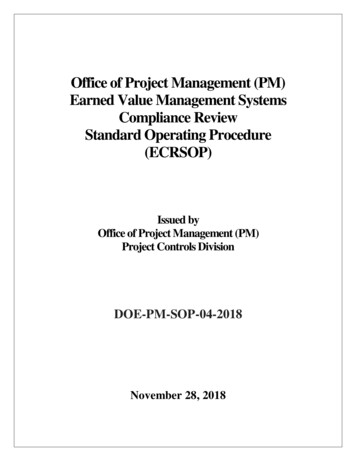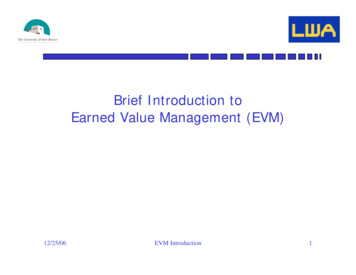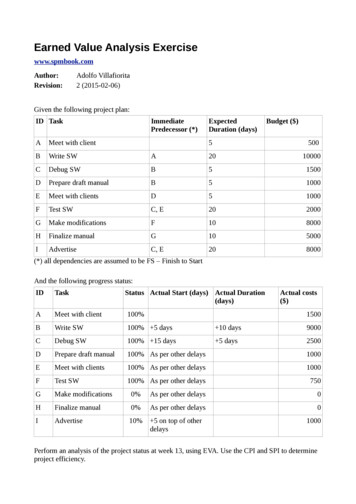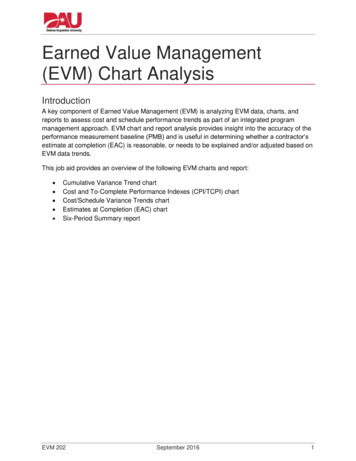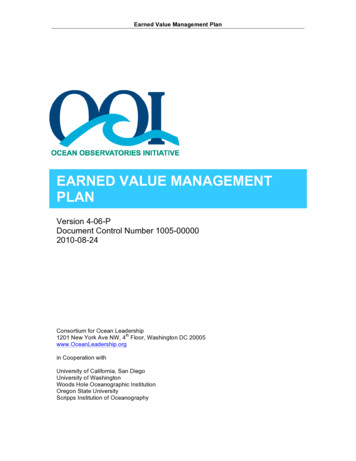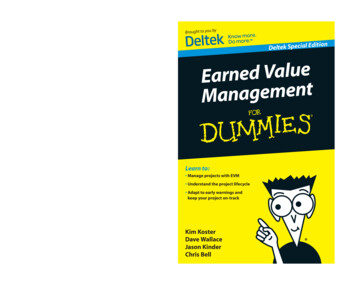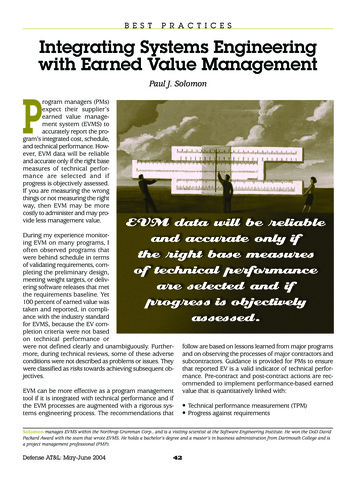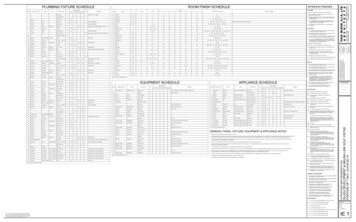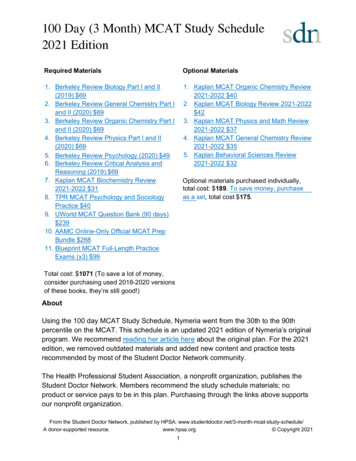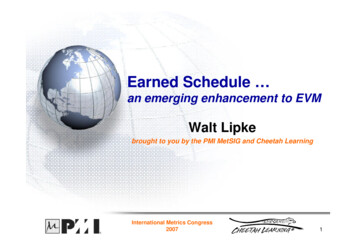
Transcription
Earned Schedule an emerging enhancement to EVMWalt Lipkebrought to you by the PMI MetSIG and Cheetah LearningInternational Metrics Congress20071
Brought To You By Cheetah Learning is Global Leader in PMP Examprep and PM Training with classes covering theglobe from the U.S. and Canada to SouthAmerica, Europe, New Zealand and Australia,India and Asia, the Middle East and Africa. Our accelerated learning techniques speedlearning and retention and drive our 97% passrate on the PMP exam. Michelle LaBrosse, Founder & Chief Cheetah,recently named one of 25 Influential Women inPM in the world. Cheetah Learning strives to raise the profile ofPM with our webinars and our Know HowNetwork column which is published in over 200publications around the world.International Metrics Congress20072
Objective Introduce the Earned Schedule ConceptDevelop the Schedule IndicatorsApply to Project Duration PredictionApply to Schedule AnalysisInternational Metrics Congress20073
Earned Value BasicsPVCPI EVACBACSPI EVPVCV SVACEVTimeInternational Metrics Congress20074
EVM Schedule Indicators SV & SPI behave erratically for projects behind schedule– SPI improves and equals 1.00 at end of project– SV improves and concludes at 0 variance Schedule indicators lose predictive ability over the last thirdof the projectInternational Metrics Congress20075
EVM Schedule Indicators Why does this happen?– SV EV – PV– SPI EV / PV At planned completion PV BAC At actual completion EV BAC When actual planned completion– SV BAC – BAC 000– SPI BAC / BAC 1.00Regardless of lateness !!International Metrics Congress20076
Earned Schedule Concept The cumulative value of ES isfound by using EV to identifyin which increment of PV thecost value occurs.Time NowSVcAΣ PVΣ EVBSVtES123456789107 months gone by, but the project only has “Earned Schedule” to Month 5Which SV “Answers the mail?” behind or 2 months behind schedule?International Metrics Congress20077
Earned Schedule Metric Required measures– Performance Measurement Baseline (PMB) – thetime phased planned values (PV) from project start tocompletion– Earned Value (EV) – the planned value which hasbeen “earned”– Actual Time (AT) - the actual time duration from theproject beginning to the time at which project status isassessed All measures available from EVMInternational Metrics Congress20078
Earned Schedule Calculation ES (cumulative) is the:Number of completed PV time increments EV exceeds the fraction of the incomplete PV increment ES C I where:C number of time increments for EV PVI (EV – PVC) / (PVC 1 – PVC)International Metrics Congress20079
Interpolation CalculationPVC 1 I /1 mo p / qI (p / q) 1 moES(calc)EV qp PVC Ip EV – PVCq PVC 1 – PVC1 moI ESMayJuneJulyEV – PVCPVC 1 – PVC 1moTimeInternational Metrics Congress200710
Earned Schedule Indicators Schedule Variance:SV(t) ES – AT Schedule Performance Index:SPI(t) ES / ATwhere AT is “Actual Time” – the duration from start to time now SV(t) and SPI(t) are time-based (months, weeks )International Metrics Congress200711
Earned Schedule Indicators What happens to the ES indicators, SV(t) & SPI(t), when theplanned project duration (PD) is exceeded (PV BAC)?They Still Work Correctly!! ES will be PD, while AT PD– SV(t) will be negative (time behind schedule)– SPI(t) will be 1.00Reliable Values from Start to Finish !!International Metrics Congress200712
Schedule Variance Comparison100 1Early Finish Project800.8600.6 Mo400.420SV(t)0.2SV( )00JFMAMJ0JASONDJFM0Late Finish Project-100-1 -200Mo-2-300-400-3JFMAMJJASOInternational Metrics Congress2007NDJFM13
Schedule Index Comparison1.12Early Finish Project1.101.081.061.041.021.00SPI( )0.98JFMAMJ1.30JASSPI(t)ONDJONDJFMLate Finish nal Metrics Congress2007FM14
Late Finish ProjectCommercial IT Infrastructure Expansion Project Phase 1Cost and Schedule Variancesat Project Projection: Week Starting 15th July xxCV cumTarget SV & CVSV (t) cum20200-20-2Stop wk 19-40-4Sched wk 20-60Re-start wk 26-6-80-8-100-10-120-12-140-14-160-161 2 3 4 5 6 7W e eksD ollars (,0 00 )SV cum8 9 10 11 12 13 14 15 16 17 18 19 20 21 22 23 24 25 26 27 28 29 30 31 32 33 34Elapsed WeeksInternational Metrics Congress200715
Earned Schedule – Key Points ES Indicators constructed to behave in an analogousmanner to the EVM Cost Indicators, CV and CPI SV(t) and SPI(t)– Not constrained by PV calculation reference– Provide duration based measures of scheduleperformance– Valid for entire project, including early and late finish Facilitates integrated Cost/Schedule project management(using EVM with ES)International Metrics Congress200716
Schedule Prediction Can the project be completed as planned?– TSPI Plan Remaining / Time Remaining (PD – ES) / (PD – AT)where PD is the planned duration (time at BAC)(PD – ES) PDWRPDWR Planned Duration for Work Remaining completed as estimated?– TSPI (PD – ES) / (ED – AT)where ED Estimated DurationTSPI ValuePredicted Outcome 1.00Achievable 1.10Not AchievableInternational Metrics Congress200717
Schedule Forecasting Long time goal of EVM Prediction of total project durationfrom present schedule status Independent Estimate at Completion (time)– IEAC(t) PD / SPI(t)– IEAC(t) AT (PD – ES) / PF(t)where PF(t) is the Performance Factor (time)– Analogous to IEAC used to predict final cost Independent Estimated Completion Date (IECD)– IECD Start Date IEAC(t)International Metrics Congress200718
Earned Schedule TerminologyEarned ScheduleEScumES C I number of completeperiods (C) plus an incompleteportion (I)Actual TimeATcumAT number of periods executedSchedule VarianceSV(t)SV(t) ES - ATSchedule PerformanceIndexSPI(t)SPI(t) ES / ATMetricsIndicatorsTo Complete SchedulePerformance IndexPredictorsIndependent Estimateat Completion (time)TSPI(t) (PD – ES) / (PD – AT)TSPI(t)TSPITSPI(t) (PD – ES) / (ED – AT)IEAC(t) IEAC(t) PD / SPI(t)IEAC(t) AT (PD – ES) / PF(t)PFInternational Metrics Congress200719
Independent Confirmation SPI(t) & SV(t) do portray the real schedule performance At early & middle project stages pre-ES & ES forecasts ofproject duration produce similar results At late project stage ES forecasts outperform all pre-ESforecasts The use of the SPI(t) in conjunction with the TSPI(t) hasbeen demonstrated to be useful for managing the scheduleStephan Vandevoorde – Fabricom Airport Systems, BelgiumInternational Metrics Congress200720
Schedule Analysis with EVM? Most practitioners analyze schedule from the bottom upusing the network schedule, independent from EVM .“It is the only way possible.”– Analysis of the Schedule is overwhelming– Critical Path is used to shorten analysis(CP is longest path of the schedule) Duration prediction using Earned Schedule provides amacro-method similar to the method for estimating Cost– A significant advance in practice But, there’s more that ES facilitates .International Metrics Congress200721
Facilitates Drill-Down Analysis ES can be applied to any level of the WBS, to include taskgroupings, such as the Critical Path (CP)– Requires creating PMB for the area of interest– EV for the area of interest is used to determine its ES Enables comparison of forecasts, total project (TP) to CP– Desired result: forecasts are equal– When TP forecast CP forecast, CP has changed– When CP TP, possibility of future problemsInternational Metrics Congress200722
ES Bridges EVM to the ScheduleBAC PVEVSV(t)TimeESInternational Metrics Congress2007ATPD23
How Can This Be Used? Tasks behind – possibility of impediments or constraints canbe identified Tasks ahead – a likelihood of future rework can be identified The identification is independent from schedule efficiency The identification can be automatedPMs can now have a schedule analysis toolconnected to the EVM Data!!International Metrics Congress200724
Current Usage & Recognition EVM Instructors– Performance Management Associates, Management Technologies,George Washington University, University of Florida Boeing Dreamliner , Lockheed Martin, US StateDepartment, Secretary of the Air Force Several Countries - Australia, Belgium, United Kingdom,USA .(Japan, Switzerland, Sweden, Spain, Brazil, India, ) Applications across weapons programs, construction,software development, Range of project size from very small and short to extremelylarge and long duration Inclusion of Emerging Practice Insert into PMI - EVMPractice Standard (2004)International Metrics Congress200725
Summary Derived from EVM data onlyProvides time-based schedule indicatorsIndicators do not fail for late finish projectsApplication is scalable up/down, just as is EVMSchedule prediction is better than any other EVM methodpresently used Application is growing in both small and large projects Practice recognized as “Emerging Practice” Facilitates bridging EVM analysis to include the ScheduleInternational Metrics Congress200726
Thank You!Walt LipkeEmail: waltlipke@cox.netThank You from the MetSIG TheInformation Highway For the Metricsof the WorldInternational Metrics Congress200727
Cheetah Learning is Global Leader in PMP Exam prep and PM Training with classes covering the globe from the U.S. and Canada to South America, Europe, New Zealand and Australia, India and Asia, the Middle East and Africa. Our accelerated learning techniques speed learning and retention and
